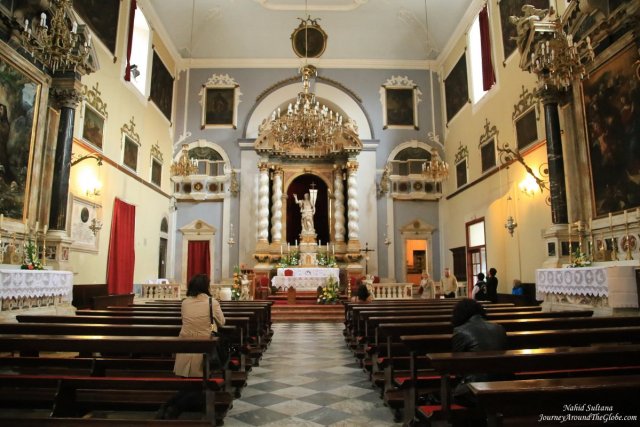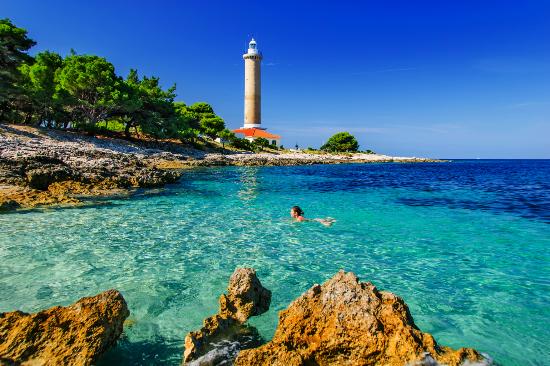
When you are in Dubrovnik, do sign up for the daily walking tour of the city because it is very informative and the local guides can offer insights about their city.
There are various timings during the day, but the regular ones are 10am and 12pm for the free walking tour. Meeting point is in front of the restaurant Nautika by the big tree.
1. Brsalje Square
Rendezvous in this leafy park, but before you enter Old Town, walk away from the street to the low balustrade. You’ll have an unobstructed view of the sea and Fort Lovrijenac to the right and the 16th-century Bokar Fortress to the left. Lovrijenac is built on a high, rocky peninsula that juts into the sea, and it is Dubrovnik’s oldest defensive structure. These days it is used as a theater for Shakespearean productions and for performances during Dubrovnik’s Summer Festival. Croatian native and TV star Goran Visjic of ER fame is a frequent performer there. Bokar was used as a prison in the 19th century.

2. Pile Gate
This is the busiest portal to Old Town, and it is really two gates you approach across a wooden drawbridge that once was pulled up each night to protect the city. Note the statue of St. Blaise carved into a niche above the opening of the 16th-century outer gate and another statue of the city’s patron (by Ivan Mestrovic) inside the even older (15th-c.) inner gate. Occasionally musicians and vendors hang out in the courtyard between the gates to catch people on their way out.
Step through the inner gate and stop a moment to orient. Walk through and note:
3. Onofrio’s Large Fountain & the Wall Walk Entrance
Walk inside the Pile Gate and immediately to the left you’ll see a steep stairway that leads up to the Minceta Tower at the top of the wall. This is one of three access points to the top of the ramparts. To the right is Onofrio’s Large Fountain, a tall concrete dome that during the Middle Ages was a collection point for water flowing into the city via an aqueduct from the Dubrovnik River 12km (7 1/2 miles) away. The fountain was more ornate when it was completed in 1444, but the iron embellishments were destroyed in the 1667 earthquake. The fountain also supplied Dubrovnik with fresh water when it was on lockdown during the 1991-92 sieges.
Stay left. The first building on your left is:

4. Church of Our Saviour
This tiny church was built as a memorial to the victims of a 1520 earthquake, but it became a symbol of strength when it became one of the few buildings to survive the 1667 quake that destroyed most of the city. Today it is used for concerts and exhibits.
Walk on a few steps to:

5. The Franciscan Monastery/Museum
Before you explore this building with its columned cloister and ancient pharmacy, note the small stone protruding from the bottom left of the church’s front and the people who keep jumping on it. This building, with its garden, architectural features, pharmacy, and museum exhibits, is worth a visit.
Exit the monastery and begin your Stradun stroll in earnest to investigate the:
6. Stradun Side Streets
The Stradun (aka Placa) runs to the clock tower and the Ploce Gate. All the buildings along the way are almost identical in style, a result of post quake construction in the 17th century. Note the arches that frame a combo door and window. The sill was used as a counter over which business was conducted. If you are up for a detour, head up Zudioska Street to visit the second-oldest synagogue in Europe and its original 17th-century furnishings.
Continue along the Stradun past Zlatarska Street to the:

7. Sponza Palace
As you approach Luza Square, look left and note the graceful Renaissance arches of the Sponza Palace, which used to be Dubrovnik’s Customs House. Today it houses the Memorial Room of the Dubrovnik Defenders, a visual tribute to the more than 300 people who were killed from October 1, 1991, to October, 26, 1992, while defending Dubrovnik against Serb attacks. Multimedia images of the destruction and photos of the young people who died in the conflict are moving reminders of the devastation that swept Croatia at that time.
Exit the palace and walk to Orlando’s Column in the center of Luza Square. Pause at:
8. Orlando’s Column and Onofrio’s Small Fountain
Orlando’s Column will be in front of you as you exit the Palace, and the Clock Tower will be to your left. Note the statue’s forearm, which was Old Ragusa’s standard of measurement (512mm/20 in.). The Clock Tower features a pair of bronze men who move up to strike the bell on the hour. The Town Hall is to the right of the Clock Tower and Onofrio’s Small Fountain is in front of that.
Turn left from the front of Orlando’s Column and walk through the passageway between the Sponza Palace and the Town Hall. Turn left and head to the Dominican Monastery:
9. Dominican Monastery, the Old Port, and the Ploce Gate
The Dominican Monastery is a complex that includes a large church, cloisters, and a museum. The original 14th-century church was destroyed in the 1667 quake, and this one was rebuilt in the 17th century. There are some interesting paintings inside, and the church doubles as a concert venue during the Summer Festival. The cloisters are a must-see with courtyard gardens and interesting stonework.
Exit the monastery and go left onto Svetoga Dominika. Continue on to explore the Old Harbor, Ploce Gate, and Revelin Fortress, and/or retrace your steps and return to Luza Square:
10. Gradska Kavana & the Rector’s Palace
As you return from the Dominican Monastery, the Town Hall and Gradska Kavana (Town Café) will be on your left. You can break for a cold drink or coffee and sit at tables facing the square or go inside to the Gradska Taverna and grab a spot on the terrace overlooking the Old Harbor. The Town Theater is also in this building. The Venetian-Gothic Rector’s Palace is adjacent to the Gradska Kavana complex fronted by pillars made of marble from Korcula and topped with interesting carvings. The interior is used for summer concerts.
Exit the Rector’s Palace and turn left:

11. Dubrovnik Cathedral
Note the minimalist gray marble altar that was installed when Roman Catholicism ruled that the priest should face the people during Mass — its block style is incongruent to the church’s Baroque design. Don’t miss the treasury, which is loaded with priceless relics, including the skull of St. Blaise and a piece of the True Cross.
Exit the cathedral and walk around to the rear and walk up Androviceva to the Jesuit Steps and Church of St. Ignatius Loyola or turn left and walk past the Rector’s Palace to return to Luza Square.
12. St. Blaise Church
This 18th-century Baroque church is a tribute to Dubrovnik’s patron saint. Inside, the altar is the main draw with its statue of the saint holding a model of the city of Dubrovnik as it was before the 1667 quake. Outside, the church’s wide steps are a popular resting/meeting place for tourists.
From St. Blaise you can return to the Pile Gate and inspect the shops along the south side of the Stradun, explore what you’ve just seen in greater depth, or venture up the steep side streets to discover more sights.


